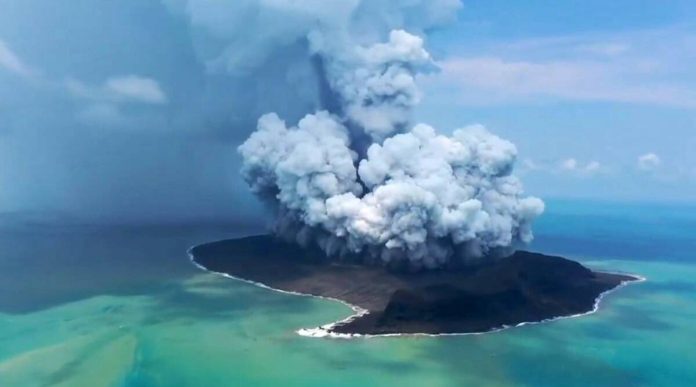Eric Kwon
Science & Technology Editor
On Jan. 14, Tonga experienced an unusually massive volcanic eruption. Though Tonga lies to the right of Australia, right below Fiji, tsunami waves reached all the way to coastal California — causing devastation. Though California itself is a coastal state, the threat of tsunamis is foreign, overshadowed by the more common phenomena of earthquakes.
Dr. Melissa Scruggs, a volcanologist from the Deparptment of Earth Science at UC Santa Barbara (UCSB), elaborates more on this topic. As a volcanologist, her interests lie with the operation of volcanoes — what happens inside a magma chamber and what causes them to erupt are some of the questions she tries to answer.
In an interview with The Bottom Line, Scruggs gives us insight on the Tonga volcanic eruption. The eruption itself, she asserted, was caused by the fact that the volcano in question was underwater, as are most volcanoes. Most of them are “spreading volcanoes,” in which the earth’s crust pulls apart, thus allowing magma to come to the surface in the recognizable form of a volcano.
“But when that happens, the magma usually comes out kind of slowly. And so you have a little bit of time for the water to build up a steam layer and protect the magma. So you don’t get super, super big explosions.” Scruggs also mentioned the factor of water pressure that keeps it from being so explosive. On the other hand, the Tonga volcano was produced by a tectonic plate going beneath another as a result of plate collision, thus allowing for more explosive reactions.
This enormous explosion was not the first of the volcano’s eruptions — in fact, as Scruggs mentioned, it had erupted earlier that day. The main volcanic reaction at Tonga was not unprecedented in the fact that it happened, but rather the scale of the eruption itself.
The main question is how and why the volcano erupted in such an immense way. Scruggs noted how intense it was, its equivalent being “exploding 10 megatons of TNT. So bigger than nuclear bomb size.” She mentioned pressure waves that went out before the mushroom cloud, which may explain why the tsunamis were so large.
Surprisingly, in comparison to the objective power of the eruption, “It doesn’t seem like there’s too much damage from the tsunami, which is very surprising from a scientific point of view and relieving from a humanitarian point of view.” Most of the focus right now is going to relief efforts, so scientific observations about this phenomenon will likely come later.
Though Tonga lies in the epicenter of the explosion, California was, of course, not victimless. Scruggs mentioned how even the UCSB campus may very well be affected by tsunamis (the Tonga waves were even spotted in Santa Barbara), emphasizing the importance of having tsunami preparedness.
The California Department of Conservation redid their tsunami hazard assessment just last year, and it can be seen that much of the campus is in a hazard zone. The entire lagoon area and areas of the University Center at UCSB lie in hazardous areas. There is some assurance though, as UCSB is certified by the National Oceanic and Atmospheric Administration as tsunami ready — perhaps not that reassuring as it is the only college campus in California to be certified.
Thankfully, this type of explosion is not one to happen too often. “I can never say it is over, but it is unlikely,” Scruggs mentioned. Given the surprisingly tame destruction that it wreaked (at least for the explosion’s size), the explosion, in conjunction with the tsunami, can help us become more vigilant with emergency preparedness and more invested in the operation of volcanoes in the future.











